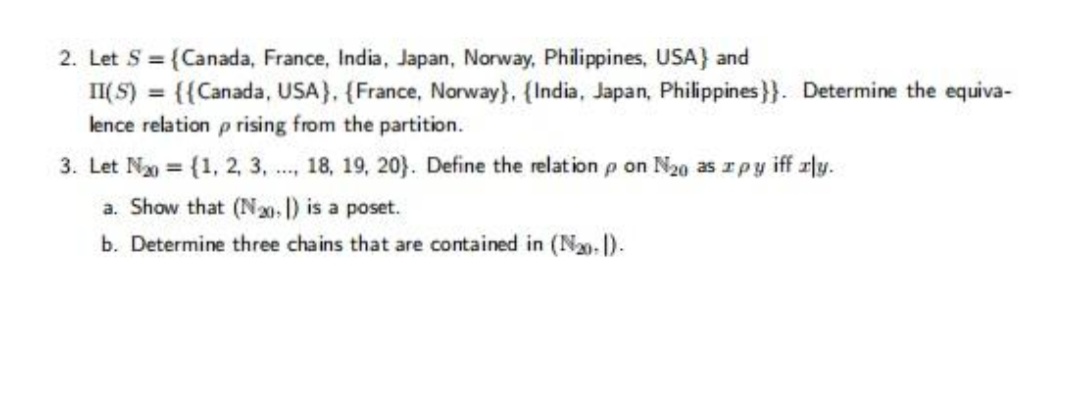2. Let S = {Canada, France, India, Japan, Norway, Philippines, USA} and II(S) = {{Canada, USA), {France, Norway}, {India, Japan, Philippines}}. Determine the equiva- lence relation p rising from the partition. 3. Let Ny = {1, 2, 3, ., 18, 19, 20}. Define the relation p on N20 as zpy iff rly. a. Show that (N20-) is a poset. b. Determine three chains that are contained in (N-).
2. Let S = {Canada, France, India, Japan, Norway, Philippines, USA} and II(S) = {{Canada, USA), {France, Norway}, {India, Japan, Philippines}}. Determine the equiva- lence relation p rising from the partition. 3. Let Ny = {1, 2, 3, ., 18, 19, 20}. Define the relation p on N20 as zpy iff rly. a. Show that (N20-) is a poset. b. Determine three chains that are contained in (N-).
Elements Of Modern Algebra
8th Edition
ISBN:9781285463230
Author:Gilbert, Linda, Jimmie
Publisher:Gilbert, Linda, Jimmie
Chapter1: Fundamentals
Section1.7: Relations
Problem 17E: In each of the following parts, a relation R is defined on the power set (A) of the nonempty set A....
Related questions
Question

Transcribed Image Text:2. Let S = {Canada, France, India, Japan, Norway, Philippines, USA} and
II( S) = {{Canada, USA}, {France, Norway}, (India, Japan, Philippines}}. Determine the equiva-
lence relation p rising from the partition.
%3D
3. Let N = {1, 2, 3, ., 18, 19, 20}. Define the relation p on N20 as rpy iff zly.
a. Show that (N- ) is a poset.
b. Determine three chains that are contained in (N. 1).
Expert Solution
This question has been solved!
Explore an expertly crafted, step-by-step solution for a thorough understanding of key concepts.
Step by step
Solved in 4 steps

Knowledge Booster
Learn more about
Need a deep-dive on the concept behind this application? Look no further. Learn more about this topic, advanced-math and related others by exploring similar questions and additional content below.Recommended textbooks for you

Elements Of Modern Algebra
Algebra
ISBN:
9781285463230
Author:
Gilbert, Linda, Jimmie
Publisher:
Cengage Learning,

Elements Of Modern Algebra
Algebra
ISBN:
9781285463230
Author:
Gilbert, Linda, Jimmie
Publisher:
Cengage Learning,